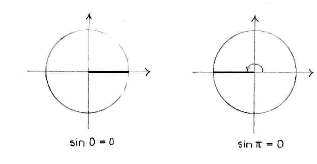Solution 4.4:2c
From Förberedande kurs i matematik 1
(Difference between revisions)
m (Lösning 4.4:2c moved to Solution 4.4:2c: Robot: moved page) |
|||
| Line 1: | Line 1: | ||
| - | { | + | There are two angles in the unit circle, |
| - | < | + | <math>x=0\text{ }</math> |
| - | + | and | |
| + | <math>x=\pi </math>, whose sine has a value of zero. | ||
[[Image:4_4_2_c.gif|center]] | [[Image:4_4_2_c.gif|center]] | ||
| + | |||
| + | We get the full solution when we add multiples of | ||
| + | <math>2\pi </math>, | ||
| + | |||
| + | |||
| + | <math>x=0+2n\pi </math> | ||
| + | and | ||
| + | <math>x=\pi +2n\pi </math>, | ||
| + | |||
| + | where | ||
| + | <math>n</math> | ||
| + | is an arbitrary integer. | ||
| + | |||
| + | NOTE: Because the difference between | ||
| + | <math>0</math> | ||
| + | and | ||
| + | <math>\pi </math> | ||
| + | is a half turn, the solutions are repeated every half turn and they can be summarized in one expression: | ||
| + | |||
| + | |||
| + | <math>x=0+n\pi </math> | ||
| + | |||
| + | |||
| + | where | ||
| + | <math>n</math> | ||
| + | is an arbitrary integer. | ||
Revision as of 13:47, 30 September 2008
There are two angles in the unit circle, \displaystyle x=0\text{ } and \displaystyle x=\pi , whose sine has a value of zero.
We get the full solution when we add multiples of \displaystyle 2\pi ,
\displaystyle x=0+2n\pi
and
\displaystyle x=\pi +2n\pi ,
where \displaystyle n is an arbitrary integer.
NOTE: Because the difference between \displaystyle 0 and \displaystyle \pi is a half turn, the solutions are repeated every half turn and they can be summarized in one expression:
\displaystyle x=0+n\pi
where
\displaystyle n
is an arbitrary integer.

